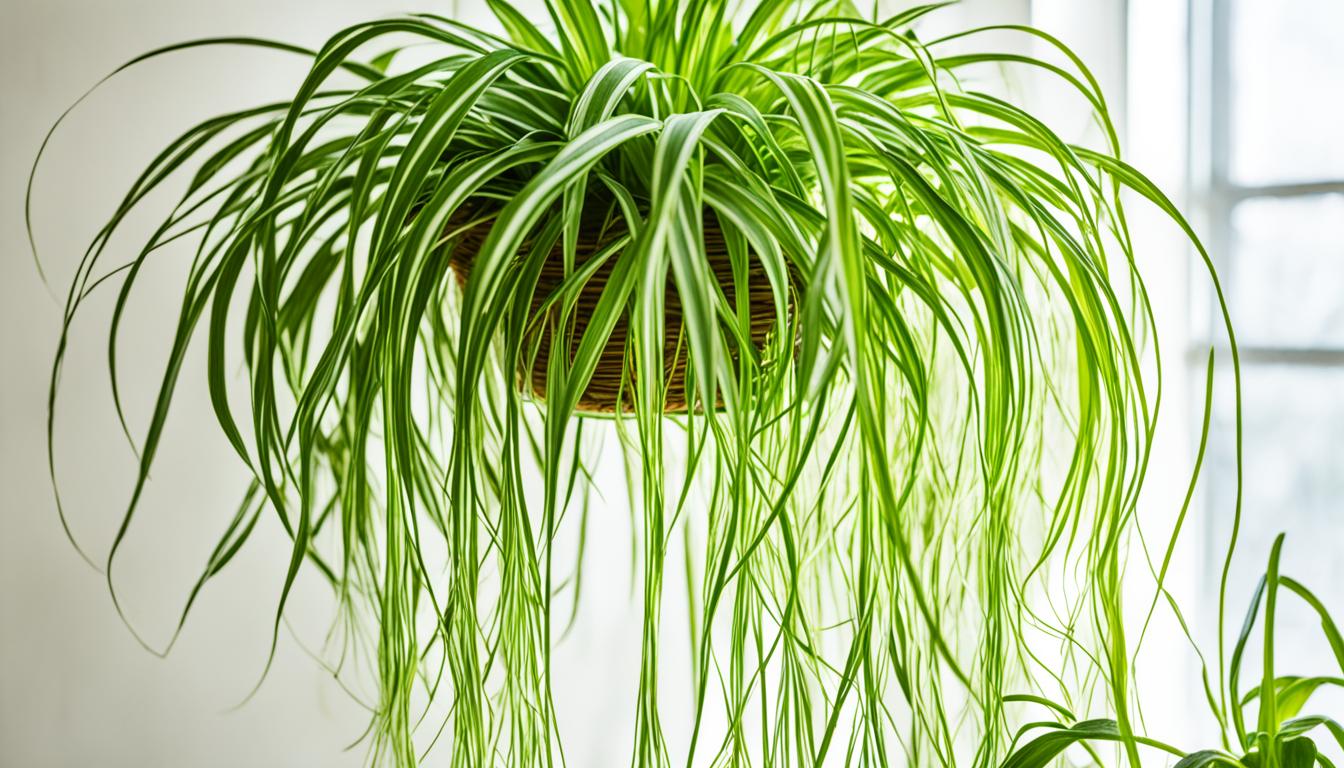Did you know spider plants can clean the air in your home? They’re pretty, easy to care for, and can take away bad toxins. This guide will show you how to grow and look after spider plants. It’s for anyone who wants a green, healthy place to live.
Key Takeaways:
- Spider plants have air-purifying abilities, making them a great choice for apartments.
- They are non-toxic to pets, ensuring a safe environment for your furry friends.
- Spider plants are compact growers but can reach up to 50cm in height.
- Proper care includes choosing the right pot and soil, providing adequate light, watering correctly, fertilizing, and monitoring for pests and diseases.
- Spider plants are known for their attractive long, narrow leaves and cascading growth habit.
Why Do We Love the Spider Plant For Apartments?
Spider plants are great for apartments. They have qualities that make them perfect indoors. Let’s see why we love them so much:
Is the Spider Plant Air-Purifying?
Spider plants help clean the air. They remove bad toxins like formaldehyde and benzene. This makes the air in your apartment better.
Is the Spider Plant Pet Friendly?
Pet owners need safe plants for their pets. Spider plants are safe for cats and dogs. So, you don’t have to worry about your pets getting sick.
How Big Does the Spider Plant Get?
Space is important in apartments. Spider plants don’t need much space. They grow up to 50cm tall but don’t take up much room.
So, spider plants clean the air, are safe for pets, and fit in small spaces. They make apartments better. Whether you want cleaner air, a safe place for pets, or some green, spider plants are great.
How to Grow a Spider Plant – Learn to Grow this Indoor Beauty
Choosing the Right Pot and Soil
Start by picking the right pot with drainage holes. This keeps roots healthy by avoiding waterlog. The pot must also be big enough for the plant’s growth.
Use a well-draining soil mix. Mix peat moss, perlite, and vermiculite for best results. This gives the plant food, air, and proper water flow.
Providing Adequate Light
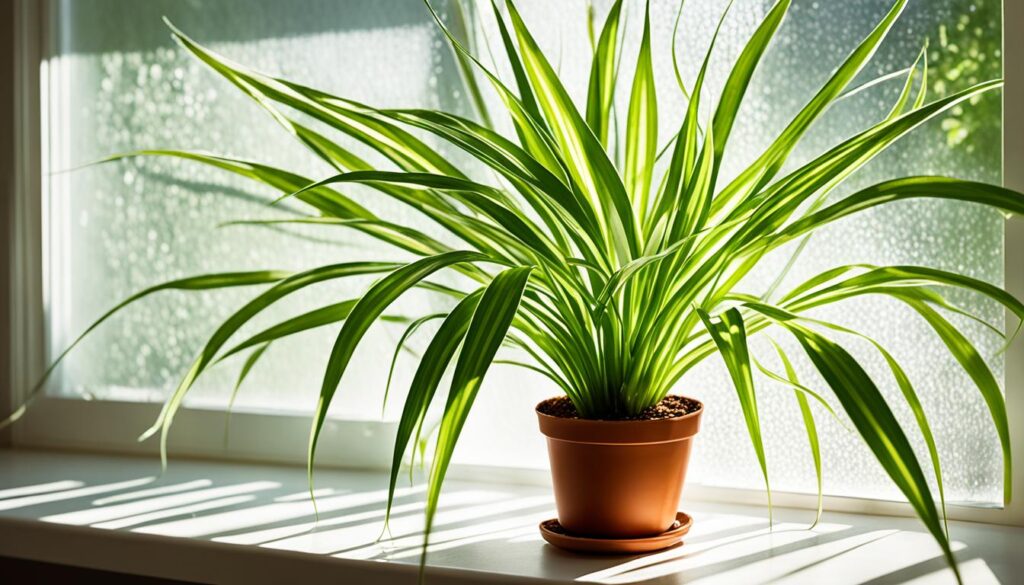
Spider plants need bright, indirect light. Keep it near a window that doesn’t let direct sunlight in. Use fluorescent or grow lights if there’s not enough natural light.
Watering and Humidity
Wait until the soil feels dry an inch down to water your spider plant. Make sure the plant gets enough water but don’t overdo it. Aim for 40-50% humidity around it.
Nutrition and Fertilization
Fertilize your spider plant regularly with a balanced fertilizer. Use a 10-10-10 or 20-20-20 mix. Follow the instructions but don’t overfertilize to avoid harming your plant.
Pruning and Maintenance
Keep your spider plant looking good by cutting off bad leaves. This also stops diseases. Trim long stems for a fuller plant. Wipe leaves with a damp cloth to remove dust.
Propagation
It’s easy to make more spider plants. Use stem cuttings or divide them. For cuttings, pick a good stem and put it in water or soil. Roots will grow soon. To divide, just separate the baby plants and pot them.
Monitoring for Pests and Diseases
Check your spider plant for pests like spider mites and diseases. Look for webs or sick leaves. Act fast to protect your plant. Good care keeps it safe from harm.
Appearance of Spider Plant
Spider plants are known as Chlorophytum comosum. They have long, narrow leaves.
Their leaves are usually bright green. Some have yellow or white streaks.
Leaves often hang over the pot’s edge. This makes a beautiful cascading look.
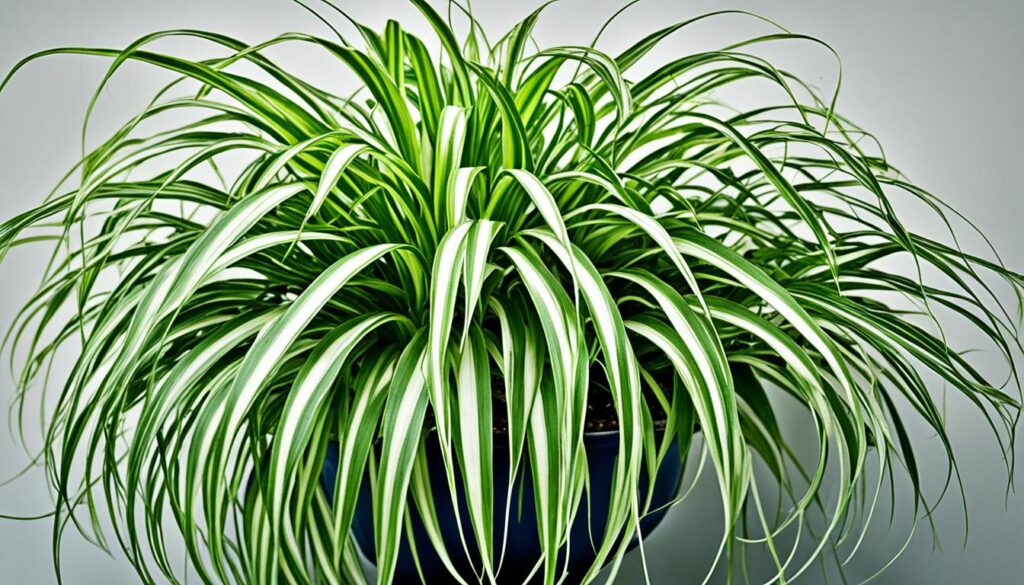
Light Requirements for Spider Plant
Spider plants like many light conditions but love bright, indirect light best. Keep them away from strong sunlight to avoid leaf damage. It’s perfect to place them near a window where the light is not too bright.
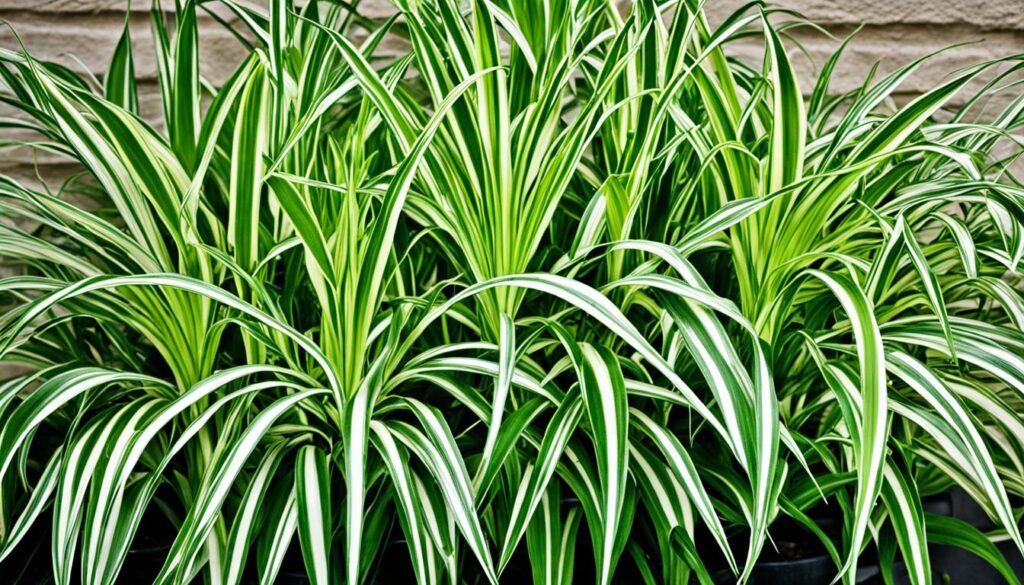
They can grow in less light, but not as fast or full. In dim light, their green leaves might look pale. Too much sun can harm them, making leaves turn brown or yellow.
Rms with east or west windows are great for spider plants. They get enough light but not too much direct sun during the day.
Turn your spider plant now and then. This makes sure it gets light on all sides. It helps the plant stay even and look good.
Watering Requirements of the Spider Plant
Watering right is key for spider plants’ health. It’s vital to know how much water they need.
Signs of Overwatering vs. Underwatering
Overwatering is a big mistake for spider plants. It can cause root rot and hurt the plant. Look out for these signs:
- Yellowing or wilting leaves
- Mushy or rotten roots
- Soggy or waterlogged soil
- Mold or fungus growth
Not giving enough water is also bad. Underwatering has these signs:
- Dry and crispy leaves
- Leaf tips turning brown
- Leaves curling or drooping
- Soil pulling away from the pot
You need to find a middle ground in watering. Spider plants like a bit of dryness between waterings.
Here’s a helpful watering schedule:
| Watering Frequency | Season |
|---|---|
| Every 7-10 days | Spring and Summer |
| Every 10-14 days | Fall and Winter |
The schedule can change with temperature, humidity, and your apartment’s conditions. Check the soil’s top two inches to know when to water. If dry, then water. If still moist, wait more days.
When you water, soak the soil fully. Let the extra water drain from the pot. Don’t let the pot stay in water. Good drainage is important for your plant’s health.
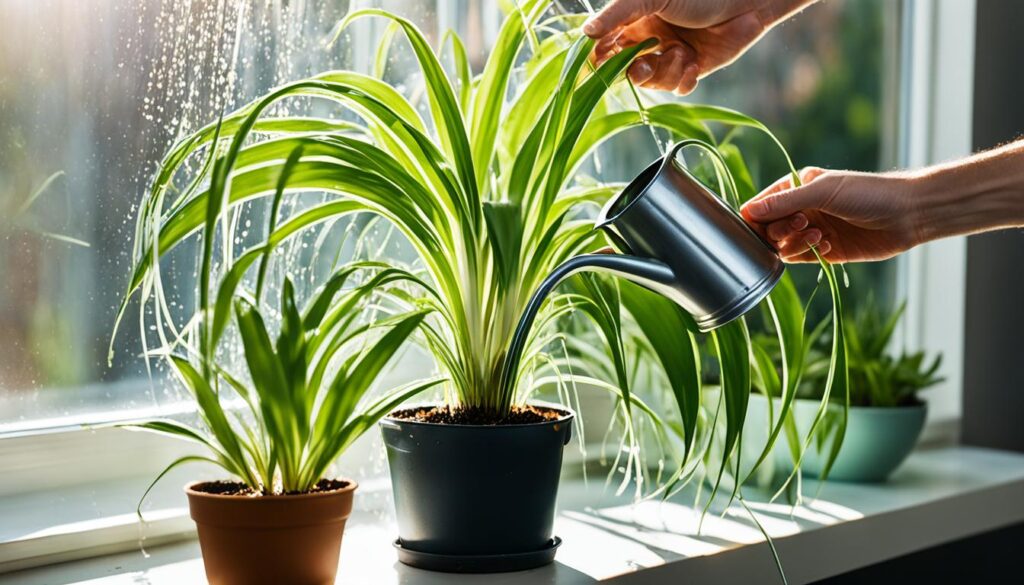
Fertilizing a Spider Plant
Recommended Fertilizer for a Spider Plant
Spider plants grow well with regular feeding during the growing season. Use a balanced fertilizer like 10-10-10 or 20-20-20. This gives them the nutrients they need to grow strong.
Look for a fertilizer made for houseplants. These give your spider plant the right food to grow. You can buy these at garden centers or online.
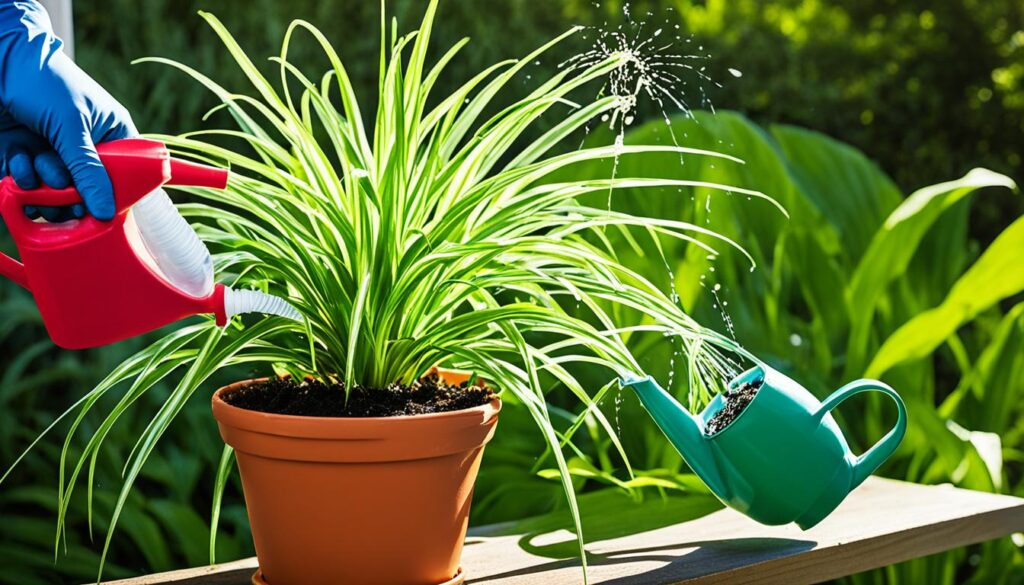
Mix the fertilizer with water as the label says. Pour it on the soil, not the leaves. Don’t put it on dry soil to avoid harm. Always water well after feeding.
Don’t give your plant too much food. This can hurt it. Feed it every 2-4 weeks in spring and summer. This is all it needs to stay healthy.
Feeding your spider plant keeps it happy and looking good. It helps it grow strong and full.
| Fertilizer | Ratio | Benefits |
|---|---|---|
| 10-10-10 | Nitrogen (10%), Phosphorus (10%), Potassium (10%) | Provides balanced nutrition for overall plant growth. |
| 20-20-20 | Nitrogen (20%), Phosphorus (20%), Potassium (20%) | Provides higher levels of essential nutrients for increased growth and vigor. |
Potting a Spider Plant
Getting the potting right is key for your spider plant’s growth and health. I’ll share how to pick the best pot, use the right soil, and when to repot.
Choosing the Right Pot Size
Picking the right pot size matters a lot. You want one just a bit bigger than your plant now. This gives the roots room to grow. But a pot too big can make the roots rot.
Tip: Spider plants like being a bit snug. So pick a pot that’s cozy but not tight.
Using the Right Potting Mix for a Spider Plant
Your spider plant will thrive with the right soil. Mix peat moss, perlite, and aged compost. This mix keeps water flowing without drowning the roots.
Tip: Keep away from heavy soils. They make the roots too wet and stress the plant.
Repotting When Necessary
Spider plants usually need a new pot every 1-2 years. Look for roots out the bottom, slow growth, or if it looks too big. These all mean it’s time to repot.
Be gentle when moving your plant. Use a new pot that’s a bit bigger. Fill any empty space with soil. Then, water it well.
Tip: Spring or early summer is the best time to repot. This is when your plant grows the most.
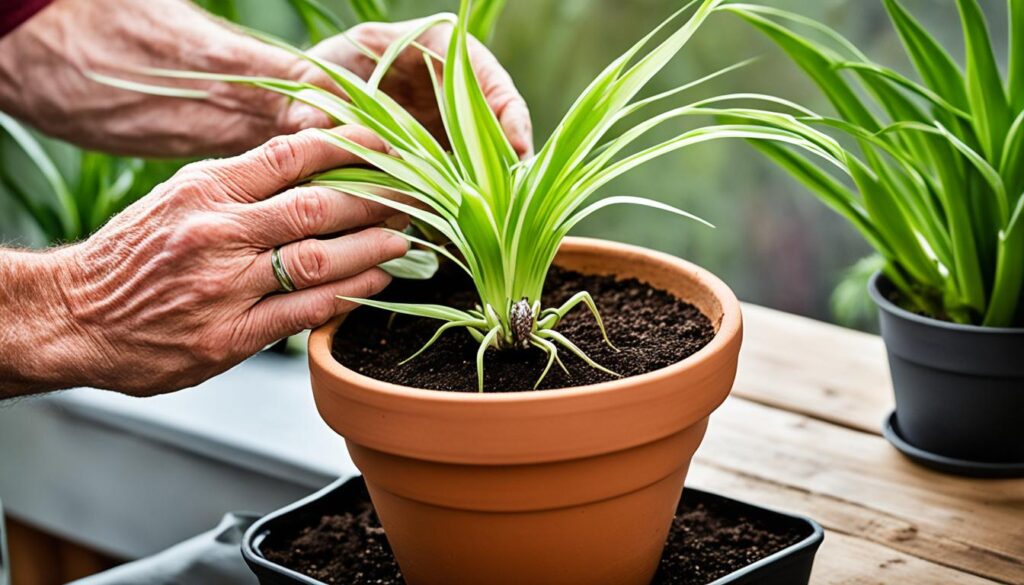
Propagating a Spider Plant
Spider plants are great at making baby plants. This makes them perfect for spreading. They can be grown through stem cuttings or by splitting them.
Stem Cuttings Or Seeds?
Stem cuttings are best for spider plants. You take a healthy stem and root it in water or soil. This way works better and faster than seeds.
Growing from seeds is a bit harder. The seeds take longer to grow. They need more care at the start.
Division Of A Spider Plant
Splitting spider plants is another way to grow more. You do this when the plant is too crowded or to grow your collection.
To split a spider plant, take off the “spiderettes” carefully. Make sure each one has roots. Then, plant them in new pots or in the garden. Take good care of them as they grow.
Stem cuttings and splitting are both fun ways to get more spider plants. Choose the way you like best.
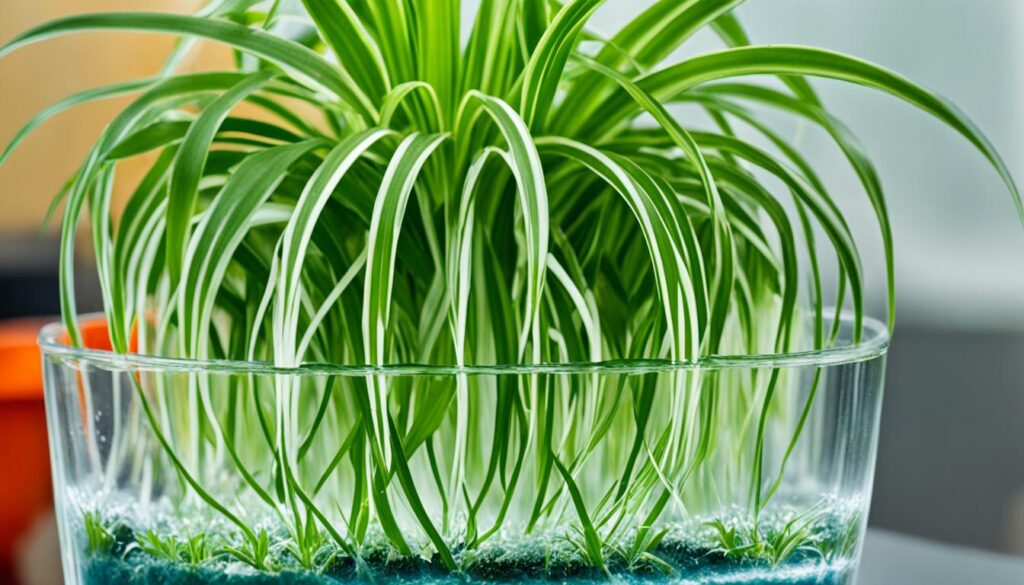
Growth and Development of the Spider Plant
Spider plants grow in a special way. They make baby plants called spiderettes from the main plant. These spiderettes look like small versions of the big plant. Over time, they grow into big spider plants too.
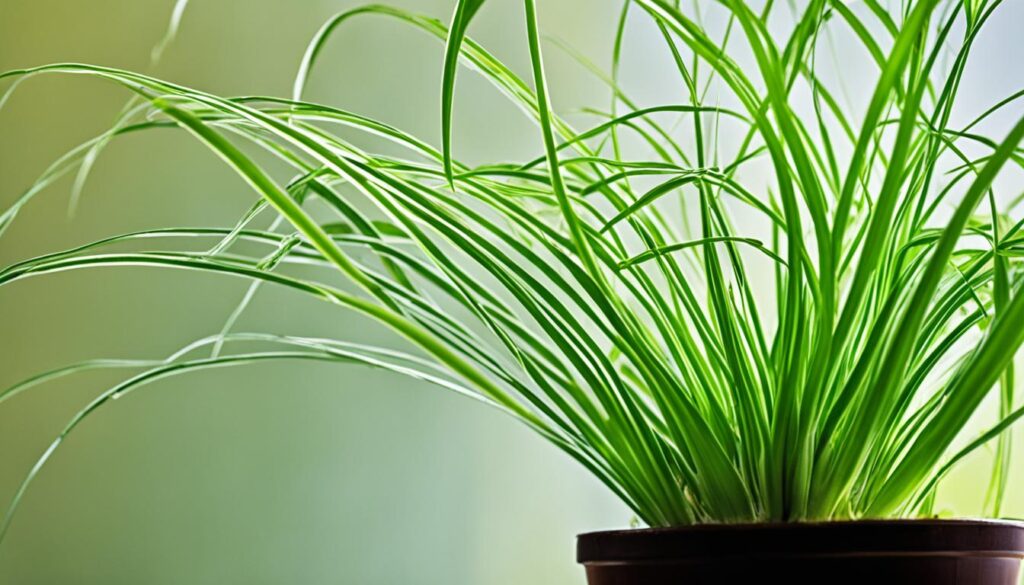
Watching spider plants grow is fun. It starts with little spiderettes. Then, they get longer and grow new roots. Each step shows how the plant is doing.
Spiderettes grow their own leaves and roots. Once big enough, they can live on their own. You can put them in their own pots. This lets spider plants have more baby plants. This makes them great for people who love plants and want more.
For a spider plant to grow well, it needs good light, water, and food. If you take care of them the right way, they will grow strong and healthy.
“Watching spider plants grow is very rewarding. Seeing new spiderettes and helping them grow is fun. It makes you feel proud and happy.”
Dealing with Pests and Diseases in the Spider Plant
Spider plants are usually healthy. But sometimes, they get sick or pest-infested. Let’s talk about the common issues they face. Also, how to keep them away or get rid of them.
Common Pests
Spider mites, aphids, and fungal infections can trouble spider plants. Knowing how to spot and fight these pests is key.
Spider mites are tiny but harmful. They live under the leaves. Look for them and the damage they cause.
Aphids attack leaves and stems. This makes the plant look weird and hurt. Watch for aphids to protect your plants.
If spider plants get too much water or live in moist air, they might get sick. Their leaves can turn rot. Water them right and keep the air fresh to avoid this.
Prevention, Identification, and Treatment
Keeping spider plants healthy means stopping pests before they start. Here are ways to do it:
- Look at your plants often for pest or disease signs.
- Clean them with a wet cloth to keep dirt and bugs away.
- Don’t overwater. Make sure the soil drains well to stop fungi.
- Good air around them stops fungus from growing.
If pests or sick leaves show up, act fast. Here’s how to help your plants:
- Use soap for bugs or neem oil on spider mites and aphids. Do what the bottle says.
- For fungus problems, take off sick leaves. Change how you water. You might need fungus killer. Ask an expert if unsure.
Spotting trouble early and fixing it keeps spider plants safe.
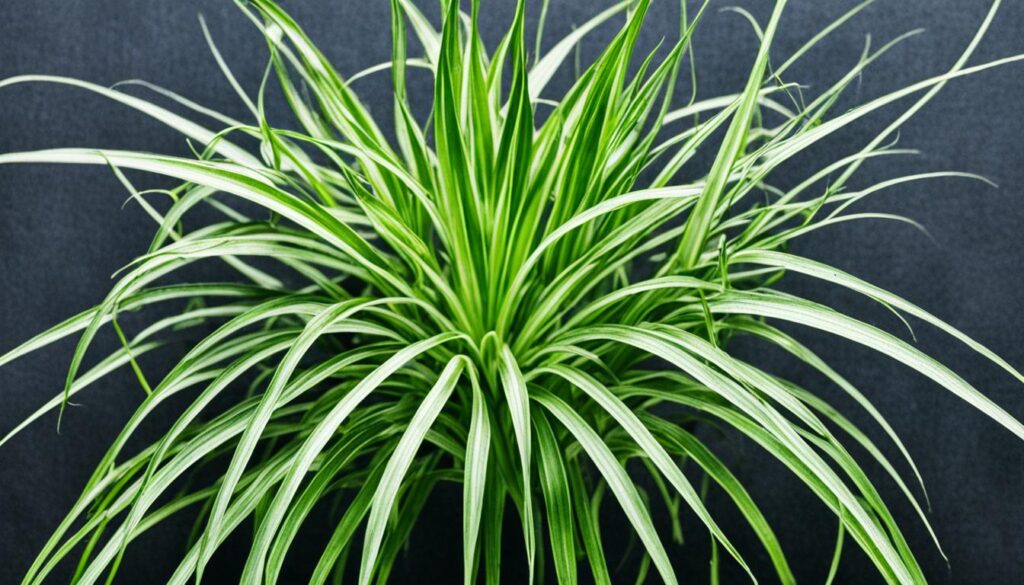
Common Spider Plant Pests
Spider plants can face pest attacks that harm them. Recognizing and dealing with these pests helps keep plants healthy.
Some pests harm spider plants:
- Spider mites: These tiny pests harm spider plants. Leaves turn yellow, dry, and brittle.
- Aphids: They feed on plant sap. This causes weird leaf growth and sticky leaves.
- Mealybugs: These bugs look white and cottony. They suck plant sap, hindering growth.
Seeing weird leaves or tiny bugs means pests are there. It’s key to act fast.
Ways to fight spider plant pests:
- Manual removal: Clean pests off with a cloth or cotton swab and rubbing alcohol.
- Insecticidal soap: Use mild soap on pests. Always follow the product’s directions.
- Natural predators: Ladybugs can help. They eat the pests in a safe way.
- Isolation: A bad infestation might mean you need to isolate the plant.
Stay alert and act quick. This way, you can stop pests and keep spider plants healthy.
Natural Predators
Natural predators help keep spider plant pests under control. Ladybugs and predatory mites eat pests like spider mites and aphids. This means you don’t need chemicals.
Isolate Infected Plants
If a spider plant gets pests, act fast to protect others. Keep sick plants away from healthy ones. This stops pests from spreading.
You can move sick plants to another room. This limits pest movement and damage.
Chemical Treatment
Sometimes, natural and isolation methods are not enough. Then, you might need chemicals. But use them carefully and only as a last option.
Follow the product’s instructions closely. Choose insecticides made for spider plant pests. This helps protect other insects and our world.
Using predators, isolation, and careful chemical use helps. It keeps spider plants and the environment safe and healthy.
Disease Prevention For Spider Plants
It’s important to keep spider plants healthy and strong. Follow some easy tips to prevent diseases.
Maintain Proper Hygiene:
Clean your spider plant’s leaves regularly. Use a damp cloth or sponge to remove dust and bugs.
Avoid Overwatering:
Spider plants don’t like too much water. Only water when the soil’s top feels dry.
This helps prevent root rot and keeps your plant happy.
Provide Adequate Air Circulation:
Good air flow is key for a healthy spider plant. Don’t let the air around it get stale or too humid.
Place it somewhere with moving air. Near a fan or in an airy spot is good.
Tips for Maintaining Spider Plants
There are a few tips that can help make your spider plants thrive. These tips ensure their health and growth.
Wiping Leaves
Wiping your spider plant’s leaves can help them stay clean. Use a damp cloth to wipe the leaves gently. This keeps the plants clean and helps them absorb more light and nutrients. It also makes your plants look better.
Outdoor Exposure
Spider plants do well with some time outdoors. Put them in a shady spot outside for a few hours each day. A covered patio or balcony works great. This helps them grow strong and healthy.
Adjusting Watering Schedule
The changing seasons mean changing how much you water your spider plants. In warmer months, your plants grow more and need more water. But in colder months, water them less to avoid root rot.
Tips for Successful Overwintering of Spider Plant
Keeping spider plants safe in winter is key. They need special care when it’s cold. Follow these tips for a happy spider plant:
- Water less in winter. Let the soil dry a bit before watering again. Stick your finger in the soil to check if it needs water.
- They like light. Put your plant near a window but not in direct sunlight.
- Keep them warm. Spider plants like it between 55°F and 75°F. Keep them away from cold drafts.
- Avoid frost. Bring your plant inside before it gets too cold.
- Don’t fertilize much. They don’t grow much in winter. You can start feeding them in spring again.
By doing these things, your spider plants will do well in winter. Then, they’ll be ready to grow when it gets warm.
Growing Spider Plant from Seed
Spider plants can grow from seeds, not just spiderettes. Here’s how to do it, including how to get and plant the seeds.
“Growing spider plants from seeds can be a rewarding experience, allowing you to witness the complete life cycle of this beautiful indoor plant.”
- Seed Collection: Get seeds from grown spiderettes. Let them dry, then take the seeds gently.
- Seed Preparation: Soak the seeds in water a few hours first. This helps them grow better.
- Planting Techniques: Use well-draining soil in a tray or pots. Seeds go ¼ inch down. Cover them lightly with soil. Soil must stay moist but not too wet.
- Germination and Growth: Seeds start growing in 2-4 weeks if warm and light. Keep them at about 70-80°F (21-27°C).
- Transplanting: Move the baby plants to their pots when big enough. They need good soil, light, and water.
Growing them this way is fun. You get to see them grow up from seeds. With care and time, you’ll have beautiful spider plants you raised yourself.
Varieties of Spider Plant
Spider plants are great at cleaning the air. They are also easy to take care of. They come in many leaf colors and patterns. These types make any place special. Here are some popular kinds and what makes them unique:
1. Chlorophytum comosum ‘Vittatum’
This kind has dark green leaves with a cream stripe in the middle. Its bold colors look amazing. ‘Vittatum’ is easy to care for and likes bright, soft light. Additionally, this plant thrives in well-draining soil and prefers to be watered moderately, allowing the top inch of soil to dry out between waterings. Its stunning foliage can serve as a striking backdrop for other plants or even for experiments with porcelain flowers making techniques. As you care for ‘Vittatum,’ consider pairing it with delicate blooms to enhance your indoor garden’s aesthetic appeal.
2. Chlorophytum comosum ‘Variegatum’
The ‘Variegatum’ has green leaves with white stripes. The stripes make it really stand out. It’s tough and can grow in different light. It’s perfect for places with changing light.
3. Chlorophytum comosum ‘Bonnie’
‘Bonnie’ plants are small with curly leaves. Their green leaves make places look fancy. This kind is good for tiny spots or to brighten up a shelf.
Different spider plants let you show your style. They make your indoor garden look amazing. Just give each kind the care it needs to stay healthy and grow well.

